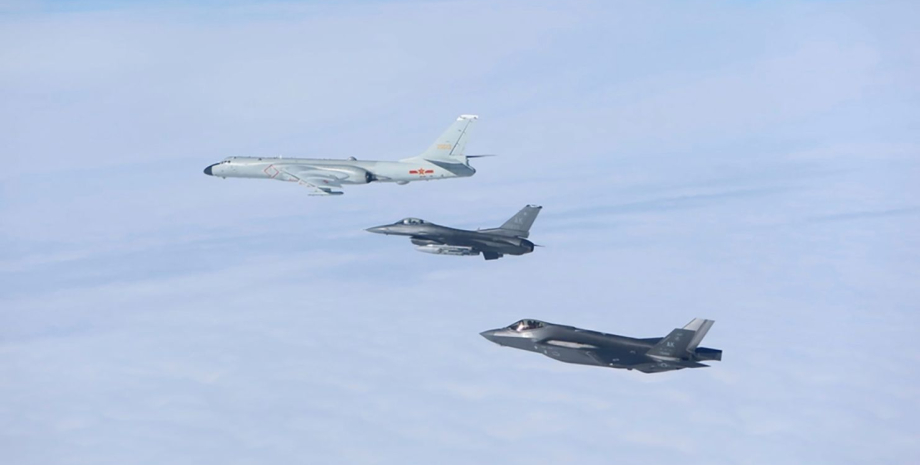
 By Eliza Popova
By Eliza Popova
But NATO is also worried that in their attempts to intimidate, the Russians may be mistaken, and the Alliance will have to respond to serious consequences. Newsweek writes about it. Cabinet and runway frames, published by the Ministry of Defense of Russia on September 24, which states that the Tu-95MC strategic bomber flies near the west coast of Alaska, were the last bold message of Moscow for NATO.
September 2024 was tense for the Norad, whose command was reported by two Russian IL-38 patrols and two Russian aircraft of marine intelligence and the Tu-142 protical struggle near Alaska. These incidents occur in the Alaska Air Defense Recognition (Adiz), which surrounds the US and Canada sovereign airspace, where planes need permission to enter or potentially face the interception.
One expert said Newsweek that the purpose of Moscow with flights is to keep NATO "in combat readiness while demonstrating the military potential of the Russian Federation. " The NORAD stated that Russia's activity was "not considered as a threat", and Moscow emphasized that its flights are made over "neutral waters", but they occur against the background of increased tensions after a full -scale invasion of the Russian Federation into Ukraine.
For thousands of miles and in 11 time zones from the US, NATO fighters Eurofighters, stationed in Latvia, were raised on September 20 and 21 to accompany the Russian aircraft near the Latvian border with Belarus. Sweden and Finland, new NATO members, have also reported some of the aircraft violations by Russian military aircraft in recent months.
Gordon "Skip" Davis, the Major General of the United States, who was the deputy assistant to the NATO Secretary General for Defense Investment, said that Russia's airspace had increased after the annexation of Crimea by Moscow in 2014 and the invasion of the Donbas. However, recent incidents may be related to the request of Ukraine to abolish restrictions on a long range for martial areas in depths of Russia and NATO's decisions to continue or increase military assistance to Ukraine.
According to Davis, when Russian military aircraft fly near NATO airspace, their transponders are usually turned off, that is, planes do not transmit transponder codes that identify their type, position and height. "In addition, they often do not present flight plans and do not communicate with civilian air traffic controllers. This behavior increases the risk of dangerous incidents or miscalculations in a crowded airspace near NATO borders," the Cepa Analysis Center (Cepa) says.
From 2013 to 2021, annual interceptions usually ranged from 290 to 350 cases. However, after the full -scale invasion of Russia into Ukraine, the situation intensified in 2022: NATO planes rising into the air about 570 times. In 2023, the number of interceptors fell to the level that was invasion, and NATO made more than 300 interceptors, mainly over the Baltic region.
According to historian Sergei Radchenko, these incidents were part of psychological operations since the Cold War, which aimed to keep the opponents in tension and force them to turn on signal intelligence and radars, "to check the readiness of the other side. " "Inadvertent escalation is a dangerous aspect of these missions, regardless of whether the Russians fly their planes near the US aircraft on the Alaska or in the Baltic Sea," Radchenko said.
On September 1, 1983, the commercial flight of the Korean Airlines on September 1, 1983, on the way from New York to Seoul, occurred after the tension between the United States and the Soviet Union and Moscow. "Well, we have more than 70 years of practice. There are some of the rules of interaction that have been developed and we have to hope that these rules are observed," said Radchenko, Professor of the School of Advanced International Research John Hopkins.
In September, Norad stated that Russian flights to the PVO zone were regular, and Davis noted that interception was a common part of NATO mission for air control, which was strengthened since February 2022. However, in July, the joint flight of Russian and Chinese bombers near Alaska in July prompted US Defense Minister Lloyd Austin to express anxiety about military cooperation between Beijing and Moscow, which has increased since the invasion of Ukraine.
On September 23, the Russo-Chinese Fleet entered the Okhotsk Sea in the western Pacific as part of the Joint Navy "Interaction-2024". Robert Merrett, a retired Viceadmiral and Deputy Director of the Security and Law Institute of Syracus University, said the increase in the number of interceptors in the international airspace and PVO is part of the transmission of sensitivity signals in high interest zones, especially regarding excessive territorial claims.
In addition to the Baltic, as well as the border regions of Russia and Alaska, the interception took place over the Japanese, Norwegian, East Chinese and South China seas. On April 1, 2001, a collision in the air between the US Navy aircraft EP-3e Aries II and the J-8 interceptor of China caused an international incident. And now the US is afraid that the situation can be repeated, only the consequences can be more serious.










All rights reserved IN-Ukraine.info - 2022